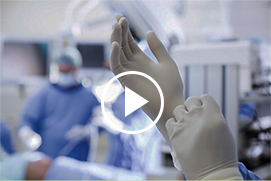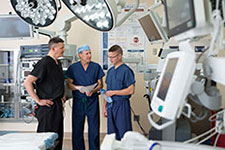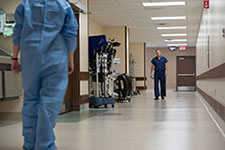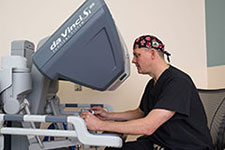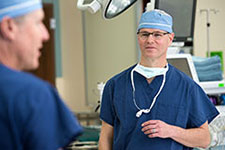What is an inguinal hernia?
An inguinal hernia (pronounced IN-gwuh-nul HER-nee-uh) is when part of your intestine pushes through a weak spot in your lower belly (abdominal) wall. This area is called the groin. The hernia creates a lump in your groin. Over time the hernia may get bigger.
Most inguinal hernias, even large ones, can be made smaller and pushed back into your belly using gentle massage and pressure.
What causes an inguinal hernia?
There are 2 types of inguinal hernias: indirect and direct.
- Indirect inguinal hernia. This is the most common type. It happens when an opening in your belly (abdominal) wall does not close normally before birth. That leaves a weak spot in the belly wall.
- Direct inguinal hernia. This type occurs mainly in adult males. It is caused by a weakening of abdominal muscle tissue over time. This happens because of aging and long-term stress on the weakened belly muscles.
Who is at risk for an inguinal hernia?
An inguinal hernia can happen at any age.
You are at greater risk for an inguinal hernia if you:
- Are male
- Are obese
- Are a pregnant woman
- Have a family history of inguinal hernias
- Smoke
Some activities may also raise your risk for an inguinal hernia. These include:
- Doing a lot of heavy lifting
- Long-term (chronic) coughing
- Straining to have a bowel movement
What are the symptoms of an inguinal hernia?
Some inguinal hernias are painful while others don’t cause any pain.
Each person’s symptoms may vary. Symptoms may include:
- A lump in the groin or in the sac that holds the testicles (the scrotum)
- Pain or pressure in the groin that gets worse when you cough, strain, lift, or exercise
- A burning feeling in the lump
- Steady, growing pain if the blood supply to the bulging part of the intestine is cut off (called a strangulated hernia)
In severe cases the intestine is partly or fully blocked. Symptoms in severe cases may also include:
- Infection
- Nausea
- Vomiting
- Lack of hunger
The symptoms of an inguinal hernia may look like other health problems. Always see your health care provider to be sure.
How is an inguinal hernia diagnosed?
Your health care provider will likely be able to tell that you have an inguinal hernia by looking at your past health and giving you a physical exam.
During the physical exam he or she will try to push the hernia back into your belly.
You may also have imaging tests including:
- Ultrasound (sonography). This creates images of blood vessels, tissues, and organs on a computer screen using high-frequency sound waves. It is used to see the intestine and abdominal wall and check blood flow through different vessels.
- X-ray. This test makes pictures of internal tissues, bones, and organs on large sheets of film. It uses invisible electromagnetic energy beams.
- CT scan. This test shows detailed images of any part of the body, such as the bones, muscles, fat, and organs. A CT scan is more detailed than a regular X-ray. It uses a combination of X-rays and computer technology to make horizontal images (often called slices) of the body.
How is an inguinal hernia treated?
A inguinal hernia will not heal on its own. Surgery is needed.
There are 2 types of surgery for an inguinal hernia: traditional open hernia repair (called herniorrhaphy) or laparoscopic hernia repair.
- Open hernia repair. The skin at the groin is cut open. The bulging intestine is pushed back into your belly and the opening in the muscle wall is sewed shut. Sometimes the weak area is fixed and made stronger with steel mesh or wire (hernioplasty).
- Laparoscopic hernia repair. A few small cuts (incisions) are made in your lower belly. A thin flexible tube (laparoscope) is put through one of the cuts. The tube has a tiny video camera in it that is attached to a screen. This lets your health care provider see inside your belly. He or she uses long thin tools in the other cuts to repair the hernia with mesh.
Inguinal hernias that are not causing any symptoms can be closely watched. If symptoms occur, the hernia can be repaired through open surgery or laparoscopic surgery.
You will need surgery right away if your small intestine gets stuck in the groin (incarcerated hernia) or if blood supply to your small intestine is blocked (strangulated hernia).
In some cases a hernia may come back after surgery. This is less likely to happen when mesh is used to support the weak belly muscles.
What are the complications of an inguinal hernia?
An inguinal hernia can lead to other problems such as:
- Incarcerated hernia. This is when part of the small intestine gets stuck in the groin and can’t be pushed back into your belly. Seek emergency medical care.
- Strangulated hernia. If the incarcerated hernia is not treated, blood supply to the small intestine is blocked. This is a life-threatening condition. Seek emergency medical care.
- Hole (perforation). The hernia may cause a hole and you may need a bowel resection. This is when the pinched-off part of the intestine, or bowel, is removed.
- Peritonitis. If the hernia is sore and the skin over it is red and warm, you may have an infection of the lining of your belly (peritonitis).
Key points about inguinal hernias
- An inguinal hernia happens when part of the intestine pushes through a weak spot in the belly (abdominal) wall.
- The hernia creates a soft lump under the skin.
- Most inguinal hernias can be pushed back into the belly with gentle massage and pressure.
- An inguinal hernia will not heal on its own. Surgery is needed.
- You will need surgery right away if your small intestine gets stuck in the groin (incarcerated hernia) or if blood supply to your small intestine is blocked (strangulated hernia).
Next steps
Tips to help you get the most from a visit to your health care provider:- Before your visit, write down questions you want answered.
- Bring someone with you to help you ask questions and remember what your provider tells you.
- At the visit, write down the names of new medicines, treatments, or tests, and any new instructions your provider gives you.
- If you have a follow-up appointment, write down the date, time, and purpose for that visit.
- Know how you can contact your provider if you have questions.
An inguinal hernia is a bulge that occurs in your groin region, the area between the lower part of your abdomen and your thigh. Inguinal hernias occur because of a weakening of the muscles in the lower abdomen.
Three layers protect the intestines inside the lower abdomen. The first is a thin membrane called the peritoneum. The second is made up of the abdominal muscles, and the third is your skin.
An inguinal hernia forms when your intestines and the peritoneum push through the muscles and appear as a bulge under your skin. Inguinal hernias are dangerous because they tend to keep getting larger and your intestine can get trapped inside the bulge and lose its blood supply. This is called a strangulated inguinal hernia, and surgery may be needed to correct the problem.
Facts about inguinal hernia
Inguinal hernias may occur on one or both sides of the body and are much more common in men than women. An inguinal hernia can appear at any age. Infants may be born with one that doesn’t show up until they become adults. About five out of every 100 children are born with the condition.
An inguinal hernia can also develop over time if you increase pressure on the walls of your abdominal muscles through activities like straining to go to the bathroom, coughing over a long period, being overweight, or lifting heavy weights. If you have a family history of inguinal hernia, you may be at a higher risk for one. Infants born before their due date are also at higher risk.
Types of inguinal hernia
Inguinal hernias come in two types:
- Indirect inguinal hernia. This is the most common type, and a type of hernia that you may be born with. Although it can occur in men and women, it is much more common in men. This is because the male testicle starts inside the abdomen and has to go down through an opening in the groin area to reach the scrotum (the sac that holds the testicles). If this opening does not close at birth, a hernia develops. In women, this type of hernia can occur if reproductive organs or the small intestine slides into the groin area because of a weakness in the abdominal muscles.
- Direct inguinal hernia. This type of hernia is caused by weakening of your abdominal muscles over time and is more likely to be seen in adults. Direct inguinal hernias occur only in men.
Symptoms
The main symptom is a visible bulge in your groin area. In men, an inguinal hernia may extend down into the scrotum and cause an enlarged scrotum. Small hernias may slide back and forth through the opening in the abdomen and not cause any symptoms. Larger hernias may be massaged back into the abdomen. Symptoms of hernias that go back and forth include:
- A bulge that increases in size when you strain and disappears when you lie down
- Sudden pain in your groin or scrotum when exercising or straining
- A feeling of weakness, pressure, burning, or aching in your groin or scrotum
An inguinal hernia that can't be moved back into the abdomen is called an incarcerated hernia. This is a dangerous situation because the part of your intestine inside the hernia can become strangulated, which is a medical emergency. Symptoms of a strangulated inguinal hernia include:
- Severe pain and redness
- Pain that keeps getting worse
- Fever
- Rapid heart rate
- Nausea and vomiting
Diagnosis
Inguinal hernia is most often diagnosed through a medical history and physical examination. Your doctor will ask you questions about hernia symptoms. During the exam, he or she will look for and feel for a bulge in your groin or scrotal area. You may be asked to stand and cough to make the hernia appear. Inguinal hernias in children may only be seen or felt when the child cries.
Treatment
The way to repair an inguinal hernia is usually with a surgical procedure. In adults with small hernias that don’t cause symptoms, treatment may only be to watch it. Adults with symptoms and most children usually have surgery to prevent the possible complication of a strangulated hernia in the future. An incarcerated or strangulated hernia may need emergency surgery.
There are two main types of surgery for inguinal hernia:
- Open repair. An incision is made through the skin in the groin area. The surgeon moves the hernia back inside the abdomen and closes the abdominal wall with stitches. Sometimes, if the opening is large, the surgeon may use a synthetic (manufactured) mesh to strengthen the closure.
- Laparoscopy. This type of surgery uses a few small incisions and a thin scope with a tiny camera. The surgeon works through the scope to repair the hernia. Synthetic mesh may also be used in laparoscopic hernia surgery. Recovery time after laparoscopy may be shorter than for open repair.
Prevention
There is nothing you can do to prevent an indirect inguinal hernia, the type you are born with. Direct hernias that occur over time may be prevented with these precautions:
- Learn how to lift heavy objects properly.
- Avoid and, when needed, treat constipation to prevent straining when having a bowel movement.
- Get treatment for any persistent cough.
- If you are a man with an enlarged prostate and you strain to pass urine, get treated.
- If you are overweight, lose the extra pounds.
Managing inguinal hernia
If you have had surgery for inguinal hernia, it is important to follow all your doctor's instructions and keep your follow-up appointments. Getting out of bed and walking is an important part of recovery and helps prevent complications. You can help to keep an inguinal hernia from coming back after surgery by avoiding heavy lifting and other strenuous activity. Ask your doctor what types of activities are safe and when you can return to work.
If you have a small hernia that is being watched or a repaired hernia, take steps to avoid becoming constipated. Eat lots of fiber, drink plenty of fluids, exercise, and go to the bathroom when you feel the urge.
Call your doctor if your inguinal hernia symptoms get worse, and always call right away if:
- You have a painful bulge that can't be pushed back inside.
- You have increasing pain, swelling, or redness.
- You have nausea, fever, or vomiting along with hernia pain.



